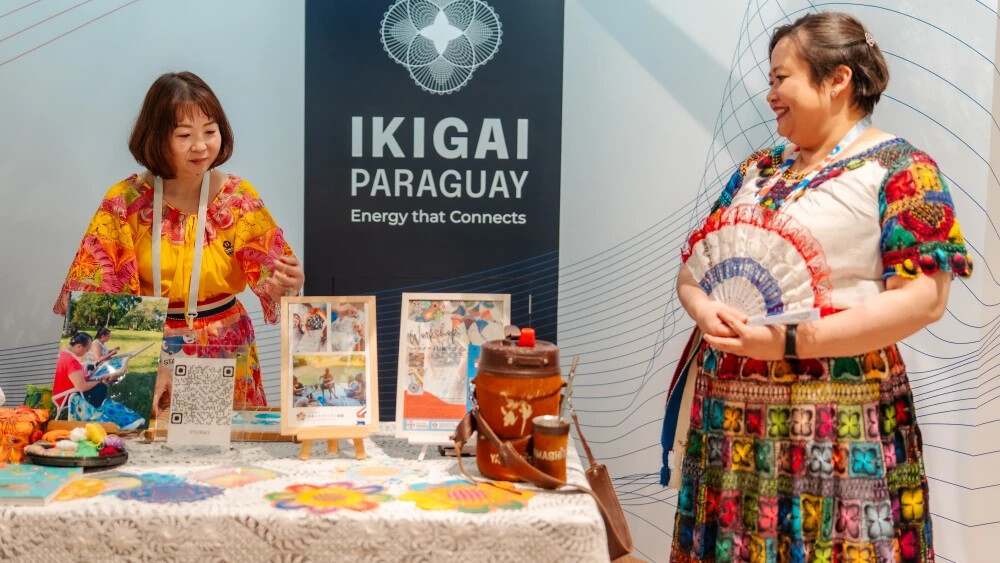
OSAKA, JAPAN – The Paraguay Pavilion drew considerable attention from visitors on its opening day at the Osaka Expo, which commenced on Yumeshima, an artificial island in Osaka Bay, Japan.
Under the theme 'Ikigai Paraguay: Energy That Connects,' the Paraguay Pavilion showcases not only Paraguay's traditional culture and its rich and diverse nature but also its dynamic industrial landscape, with a particular emphasis on renewable energy.
In an interview with the Spanish news agency EFE, José Agüero, Deputy Commissioner General of Paraguay for the Osaka Expo, stated, "We want to show what we do well, what the world needs from us, or what we can offer the world."
'Ikigai' Paraguay: A Bridge Connecting Cultures at the Osaka Expo
The Paraguay Pavilion reflects the Osaka Expo's aim of reconnecting cultures and nations under the common theme of 'Designing Future Society for Our Lives.'
Agüero emphasized, "Paraguay connects several countries through its energy, based on its people, economy, culture, and tourism. Located in the heart of South America, Paraguay serves as a 'hub' connecting the entire region."
Through this expo, Paraguay aims to present itself as "a dynamic country with a vibrant culture and a vision for a sustainable future," ready to "connect with the world and present its vision for the future society."
Exhibition of Paraguayan Traditional Crafts and 'Ñandutí' Weaving Demonstrations
The Paraguay Pavilion features a variety of handicrafts made by indigenous communities, including pottery pieces and wood carvings.
Additionally, a 15-square-meter space hosts 'Ñandutí' weaving workshops conducted by Japanese and Japanese-Paraguayan (Nikkei) instructors from the Japan Ñandutí Weaving Association.
'Ñandutí,' meaning 'spider web' in Guarani, is a traditional Paraguayan lace fabric created by weaving various colored threads on a radial circular frame to form diverse patterns such as flowers and animals. Widely used in clothing and accessories like hats, Ñandutí originated in the Canary Islands and has evolved through local artisans into a unique Paraguayan cultural expression that has garnered significant international interest.
Mie Elena Iwatani of the Japan Ñandutí Weaving Association explained to EFE that Ñandutí is a testament to this cultural fusion. Born in Paraguay to Japanese parents who immigrated before World War II, Iwatani has authored a Japanese book on Ñandutí craftsmanship, which will soon be published in Spanish.
As a Ñandutí expert, Iwatani is part of the approximately 10,000-strong Nikkei community, who form a strong cultural and historical link between the people of Paraguay and Japan.
Expo Expected to Catalyze Business Opportunities
Agüero expressed his hope that Paraguay's participation in the Osaka Expo will provide closer access to business leaders from Japan and the 158 participating countries, generating business opportunities and investments in digital technology, the agri-food industry, manufacturing, and renewable energy – sectors in which Asunción (the capital of Paraguay) is focusing its efforts. Paraguay is one of the world's largest producers of hydroelectric power per capita.
In this context, to commemorate Paraguay Day on May 19th, Paraguayan President Santiago Peña will visit Japan along with a delegation of around 50 Paraguayan business representatives to meet with Japanese companies.
Located within a shared building with other national pavilions, the Paraguay Pavilion welcomed a significant number of visitors on its opening day and is expected to maintain a steady stream of visitors in the common exhibition area, which anticipates around 10,000 daily visitors.
The Osaka Expo will be open to the public until October 13th, with organizers aiming to attract approximately 28 million visitors.
[Copyright (c) Global Economic Times. All Rights Reserved.]






























